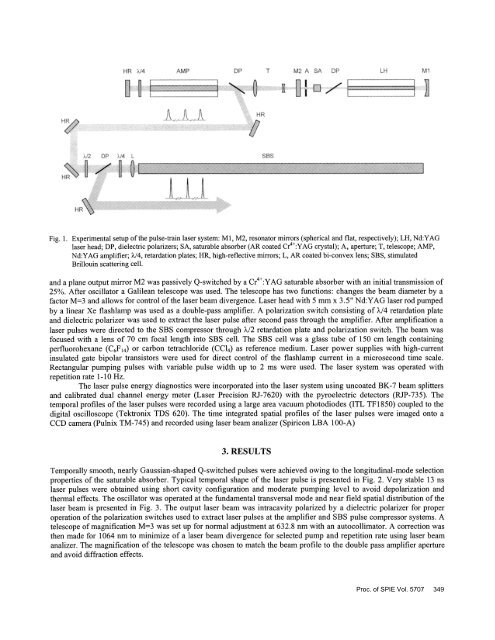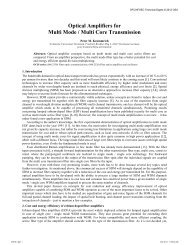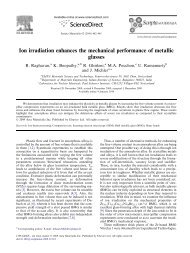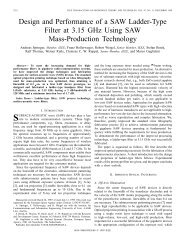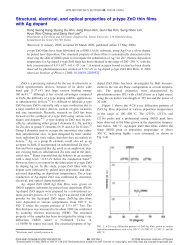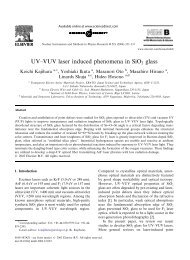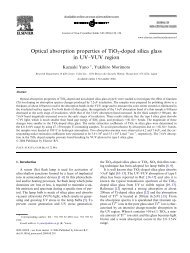Passively Q-switched nanosecond pulse-train Nd:YAG laser system
Passively Q-switched nanosecond pulse-train Nd:YAG laser system
Passively Q-switched nanosecond pulse-train Nd:YAG laser system
You also want an ePaper? Increase the reach of your titles
YUMPU automatically turns print PDFs into web optimized ePapers that Google loves.
i:i] T''""<br />
:: ;UL_J "H— "'""""<br />
!<br />
1<br />
" :: "I""'":: ::. :<br />
..<br />
"<br />
__ -J<br />
Fig. 1. Experimental setup ofthe <strong>pulse</strong>-<strong>train</strong> <strong>laser</strong> <strong>system</strong>: Ml, M2, resonator mirrors (spherical and flat, respectively); LH, <strong>Nd</strong>:<strong>YAG</strong><br />
<strong>laser</strong> head; DP, dielectric polarizers; SA, saturable absorber (AR coated Cr4:<strong>YAG</strong> crystal); A, aperture; T, telescope; AMP,<br />
<strong>Nd</strong>:<strong>YAG</strong> amplifier; 2/4, retardation plates; HR, high-reflective mirrors; L, AR coated bi-convex lens; SBS, stimulated<br />
Brillouin scattering cell.<br />
and a plane output mirror M2 was passively Q-<strong>switched</strong> by a Cr4:<strong>YAG</strong> saturable absorber with an initial transmission of<br />
25%. After oscillator a Galilean telescope was used. The telescope has two functions: changes the beam diameter by a<br />
factor M=3 and allows for control ofthe <strong>laser</strong> beam divergence. Laser head with 5 mm x 3.5" <strong>Nd</strong>:<strong>YAG</strong> <strong>laser</strong> rod pumped<br />
by a linear Xe flashlamp was used as a double-pass amplifier. A polarization switch consisting of 2/4 retardation plate<br />
and dielectric polarizer was used to extract the <strong>laser</strong> <strong>pulse</strong> after second pass through the amplifier. After amplification a<br />
<strong>laser</strong> <strong>pulse</strong>s were directed to the SBS compressor through 2/2 retardation plate and polarization switch. The beam was<br />
focused with a lens of 70 cm focal length into SBS cell. The SBS cell was a glass tube of 150 cm length containing<br />
perfluorohexane (C6F14) or carbon tetrachioride (Cd4) as reference medium. Laser power supplies with high-current<br />
insulated gate bipolar transistors were used for direct control of the flashlamp current in a microsecond time scale.<br />
Rectangular pumping <strong>pulse</strong>s with variable <strong>pulse</strong> width up to 2 ms were used. The <strong>laser</strong> <strong>system</strong> was operated with<br />
repetition rate 1-10 Hz.<br />
The <strong>laser</strong> <strong>pulse</strong> energy diagnostics were incorporated into the <strong>laser</strong> <strong>system</strong> using uncoated BK-7 beam splitters<br />
and calibrated dual channel energy meter (Laser Precision RJ-7620) with the pyroelectric detectors (RJP-735). The<br />
temporal profiles of the <strong>laser</strong> <strong>pulse</strong>s were recorded using a large area vacuum photodiodes (ITL TF 1 850) coupled to the<br />
digital oscilloscope (Tektronix TDS 620). The time integrated spatial profiles of the <strong>laser</strong> <strong>pulse</strong>s were imaged onto a<br />
CCD camera (Pulnix TM-745) and recorded using <strong>laser</strong> beam analizer (Spiricon LBA 100-A)<br />
3. RESULTS<br />
Temporally smooth, nearly Gaussian-shaped Q-<strong>switched</strong> <strong>pulse</strong>s were achieved owing to the longitudinal-mode selection<br />
properties of the saturable absorber. Typical temporal shape of the <strong>laser</strong> <strong>pulse</strong> is presented in Fig. 2. Very stable 13 ns<br />
<strong>laser</strong> <strong>pulse</strong>s were obtained using short cavity configuration and moderate pumping level to avoid depolarization and<br />
thermal effects. The oscillator was operated at the fundamental transversal mode and near field spatial distribution of the<br />
<strong>laser</strong> beam is presented in Fig. 3. The output <strong>laser</strong> beam was intracavity polarized by a dielectric polarizer for proper<br />
operation of the polarization switches used to extract <strong>laser</strong> <strong>pulse</strong>s at the amplifier and SBS <strong>pulse</strong> compressor <strong>system</strong>s. A<br />
telescope of magnification M=3 was set up for normal adjustment at 632.8 nm with an autocollimator. A correction was<br />
then made for 1064 nm to minimize of a <strong>laser</strong> beam divergence for selected pump and repetition rate using <strong>laser</strong> beam<br />
analizer. The magnification of the telescope was chosen to match the beam profile to the double pass amplifier aperture<br />
and avoid diffraction effects.<br />
Proc. of SPIE Vol. 5707 349


